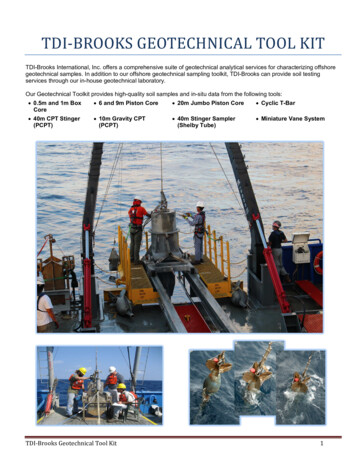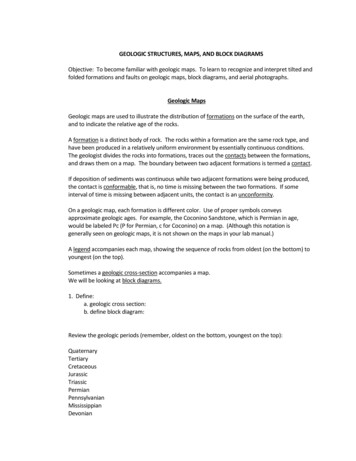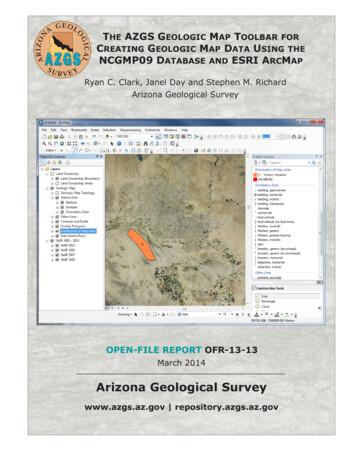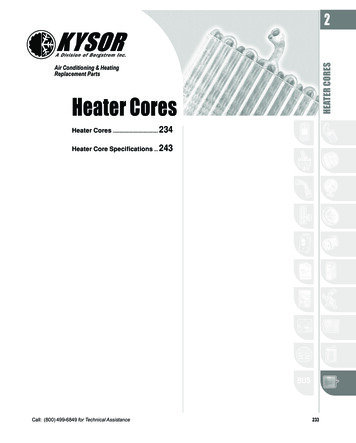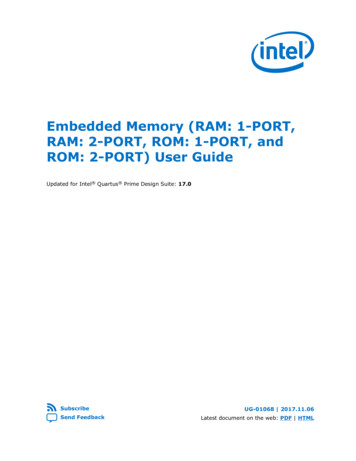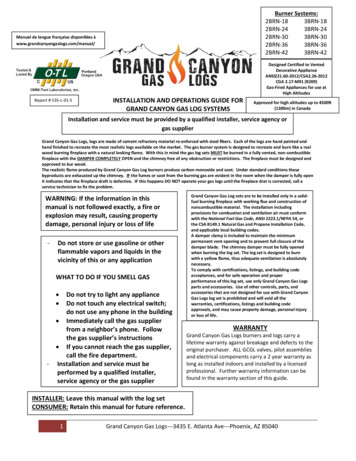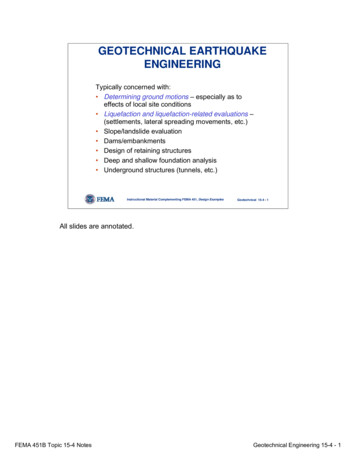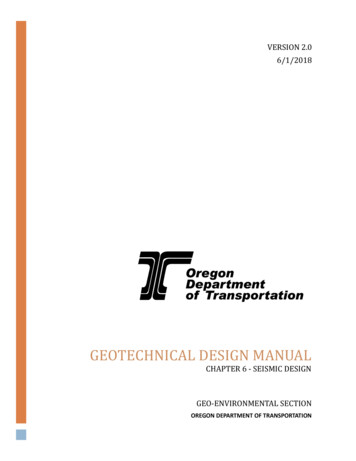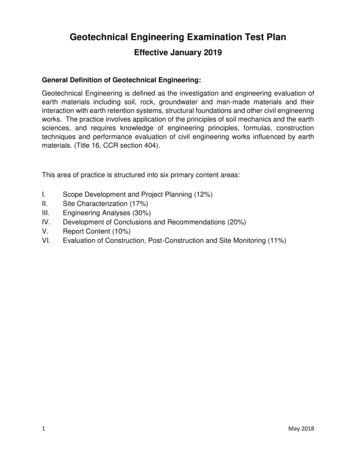
Transcription
Prepared in cooperation with the California Department of Water ResourcesGeologic Logs of Geotechnical Cores From theSubsurface Sacramento-San Joaquin Delta, CaliforniaOpen-File Report 2014–1127U.S. Department of the InteriorU.S. Geological Survey
COVERCores from the California Department of Water Resources geotechnical boreholes drilled in the Sacramento-SanJoaquin Delta, California. Photograph by Katherine Maier, 2013.
Prepared in cooperation with the California Department of Water ResourcesGeologic Logs of Geotechnical Cores From theSubsurface Sacramento-San Joaquin Delta, CaliforniaBy Katherine L. Maier, Daniel J. Ponti, John C. Tinsley, Emma Gatti, and Mark PagenkoppOpen-File Report 2014–1127U.S. Department of the InteriorU.S. Geological Survey
U.S. Department of the InteriorSALLY JEWELL, SecretaryU.S. Geological SurveySuzette M. Kimball, Acting DirectorU.S. Geological Survey, Reston, Virginia: 2014For more information on the USGS—the Federal source for science about the Earth,its natural and living resources, natural hazards, and the environment—visithttp://www.usgs.gov or call 1–888–ASK–USGSFor an overview of USGS information products, including maps, imagery, and publications,visit http://www.usgs.gov/pubprodTo order this and other USGS information products, visit http://store.usgs.govSuggested citation:Maier, K.L., Ponti, D.J, Tinsley, J.C., Gatti, E., Pagenkopp, M., 2014, Geologic logs of geotechnical cores from thesubsurface Sacramento-San Joaquin Delta, California: U.S. Geological Survey Open-File Report 2014-1127, XXp.,http://dx.doi.org/10.3133/ofr20141127.Any use of trade, firm, or product names is for descriptive purposes only and does not implyendorsement by the U.S. Government.Although this information product, for the most part, is in the public domain, it also may containcopyrighted materials as noted in the text. Permission to reproduce copyrighted items must besecured from the copyright owner.ISSN 2331-1258 (online)
ContentsAbstract . 1Introduction . 1Methodology. 3Geotechnical Drilling and Retained Samples. 3Geologic Core Descriptions . 5Sampling . 8Graphic Logs . 8Discussion . 9Acknowledgements . 9References Cited . 10Figures . 13Tables . 15Appendix . Available onlineFigures1.Map of borehole locations . 132.Explanation for graphic core logs. . 14Tables1.Geotechnical borehole and core data in this report. . 152.Sample abbreviations in core logs. . 16iii
Conversion FactorsInch/Pound to SIMultiplyByTo obtainLengthinch (in.)2.54inch (in.)centimeter (cm)25.4millimeter (mm)foot (ft)0.3048meter (m)mile (mi)1.609kilometer (km)Area2square mile (mi )square kilometer (km2)2.590SI to Inch/PoundMultiplyByTo obtainLengthcentimeter (cm)0.3937inch (in.)millimeter (mm)0.03937inch (in.)meter (m)3.281foot (ft)kilometer (km)0.6214mile (mi)Area2square kilometer (km )square mile (mi2)0.3861iv
Geologic Logs of Geotechnical Cores From theSubsurface Sacramento-San Joaquin Delta, CaliforniaBy Katherine L. Maier, Daniel J. Ponti, John C. Tinsley, Emma Gatti, and Mark PagenkoppAbstractThis report presents and summarizes descriptive geologic logs of geotechnical cores collectedfrom 2009–12 in the Sacramento–San Joaquin Delta, California, by the California Department of WaterResources. Graphic logs are presented for 1,785.7 ft of retained cores from 56 borehole sites throughoutthe Sacramento-San Joaquin Delta. Most core sections are from a depth of 100–200 feet. Coresprimarily contain mud, silt, and sand lithologies. Tephra (volcanic ash and pumice), paleosols, andgravels are also documented in some core sections. Geologic observations contained in the core logs inthis report provide stratigraphic context for subsequent sampling and data for future chronostratigraphicsubsurface correlations.IntroductionIn this report, areas from south of Sacramento to Clifton Court Forebay are considered a part ofthe Sacramento–San Joaquin Delta (the delta) (fig. 1). Since 2009, the California Department of WaterResources (CDWR) has led an ongoing drilling and coring program in the delta, supported by the DeltaHabitat Conservation and Conveyance Program (DHCCP), to inform the design and construction ofplanned water-conveyance systems. Cores were obtained during drilling and described onsite by CDWRgeologists and their contractors for engineering purposes. In 2012, the U.S. Geological Survey (USGS)
entered into a cooperative agreement with CDWR to examine the newly collected subsurface data as away to provide an enhanced Quaternary stratigraphic framework for the subsurface delta.The Sacramento–San Joaquin Delta includes the lower reaches of the Sacramento and SanJoaquin Rivers and the confluence of these two rivers, upstream from San Francisco Bay. Much ofCalifornia relies on the fresh water supply that travels through the delta. The delta also supports diverseand vulnerable ecosystems; as a result, it has become a site for numerous risk assessment, landmanagement, water resource, infrastructure, and agriculture studies (for example, Ingebritsen and others,2000). Agricultural modification in the Sacramento–San Joaquin Delta has led to compaction of peatsoils and subsidence of the land surface below sea level over much of the delta (Deverel and Rojstaczer,1996; Ingebritsen and others, 2000; Mount and Twiss, 2005; Coons and others, 2008). As a result,levees and a complex system of waterways have been constructed to keep seawater out of California’sfreshwater supplies and prevent destructive flooding of the islands within the delta (Jackson andPaterson, 1977; Ingebritsen and others, 2000; Burton and Cutter, 2008). The levees may be vulnerable tocatastrophic failure by way of ground motion and liquefaction related to earthquakes on local faults andon faults in the adjacent, tectonically active San Francisco Bay area, which has experienced severallarge-magnitude ( M6.0) earthquakes in historical times (Unruh and Krug, 2007).Given the environmental and water resources in the delta, there is increasing need for animproved understanding of the likelihood and potential impacts of natural hazards in the region.Geological context for the recently obtained geotechnical data is needed to inform future subsurfaceexploration by CDWR, to plan subsurface water-conveyance facilities, and to improve ongoing seismicand liquefaction hazards assessments in the delta.A detailed understanding of subsurface Quaternary stratigraphy is essential to evaluating seismicand liquefaction hazards in the modern Sacramento–San Joaquin Delta. Geologic logs are a crucial firststep toward establishing age, correlation, and potential tectonic deformation of the Quaternary deposits.Geologic logs are also necessary for interpreting depositional environments and the influence of these2
settings on liquefaction susceptibility and the engineering parameters that would determineinfrastructure design and performance. Although a geologic context for the Quaternary in theSacramento–San Joaquin Delta has been established from surface mapping in the region (for example,Atwater, 1982; Lettis, 1982; Unruh and others, 2009), detailed geologic data from subsurfaceQuaternary deposits older than the Holocene are lacking.The recent drilling and sampling by CDWR, which extend to depths of 200 ft subsurface,provide significant new “exposures” of the sediments that underlie the young peat and rivers on thesurface. Utilizing this new information requires a detailed examination and relogging of core samplesthat have been retained. The primary purpose of this logging is to identify attributes of the core deposits,including potential materials for dating, buried soils, and evidence of unconformities. In the future, theseobservations could be used for subsurface correlations, depositional environment interpretations, andinsights into delta evolution.This report details results of the relogging effort and includes descriptions of a total of 1,785.7 ftof core from 56 boreholes (fig. 1) collected from subsurface depths ranging from 6.5–228.1 ft (table 1).This initial core logging effort focuses on cores retained from 100–200 ft drilled depths. Additionalcores have been retained from shallower depths, primarily from boreholes near the Clifton CourtForebay in the southern delta (fig. 1), but detailed geologic logs for these additional shallow cores arenot presented herein.MethodologyGeotechnical Drilling and Retained SamplesFrom 2009–12, CDWR drilled more than 128 boreholes in the Sacramento–San Joaquin Delta,primarily along a roughly north-south trending line from south of Sacramento to Clifton Court Forebay(fig. 1). Geotechnical drilling generally involved continuous sampling using a hollow-stem auger in3
shallow, minimally consolidated sediments (on the order of several feet drilled depth), and mud rotarydrilling in sediment as much as 200 ft below the surface. In the depth range of primary interest toCDWR (generally 100–200 ft), the sampling procedure involved 3.5-ft-long punch core samplesalternated with 1.5-ft-long Standard Penetration Test (SPT) samples, occasionally interrupted by 2-ftlong Shelby Tube samples. Punch core samples were collected in unlined barrels, and they wereextruded and described at the drill site. For limited depth ranges ( 2–90 ft length within 200-ft-deepboreholes; table 1), whole cores were placed in core boxes for storage. Cores that were not retained inboxes were subsampled over a small interval ( 0.5 ft), and the remainder (minus the subsample) of thecore was discarded at the drill site. Small punch core samples and SPT samples were stored in glass jars,and some of these have been removed by CDWR for laboratory analyses (for example, particle size orAtterberg limits). Some retained jar samples were examined by the authors and sampled for tephra orpaleontological analyses, but jar samples are not described individually or documented here. MostShelby Tube samples remain unextruded and were not used this study.Retained punch core samples are stored in their original core boxes at room temperature, on openshelving, in a CDWR warehouse in West Sacramento, Calif. All of the core boxes are 2 ft in length, thusthe longest continuous core segments are 2 ft long.Geotechnical logging in the field by CDWR and their contractors classified large-scale(generally ft to tens of ft) sediment packages using the Unified Soil Classification System (AmericanSociety for Testing and Materials, 2007). Within these units, field logs documented plasticity, dilatancy,toughness, dry strength (Casagrande, 1932; Seed and others, 1966), color, grain-size distribution withinsands, hardness, and moisture. In addition, geologic observations included the presence or absence ofcarbonate, mica, peat and organic material, volcanic ash, pumice, and smaller-scale lithologic andphysical property variations.4
Geologic Core DescriptionsTo complement the CDWR core field descriptions, we examined the cores and identifiedattributes at a much finer scale (0.1 ft or less) to document subtle differences in geologic parameters thatwould assist in interpretations of depositional environment and diagenetic processes. Boxed punch coresamples were stored whole (they were not split longitudinally for field description purposes) and wereoften coated in drilling mud. Prior to detailed logging, drilling mud and other disturbed material wasscraped from one side of the core to reveal internal core color and structures. Core descriptions includedcolor (primary color, and secondary colors if mottled or banded), core disturbance, grain size, lithology(following the classification scheme defined by Shepard [1954]), bedding thickness, bed contacts,sorting, roundness, and bioturbation intensity. Additional components, such as lithologic accessories (forexample, laminae, dark minerals), physical structures (for example, sedimentary structures, loading),fossils, trace fossils, diagenetic features (for example, pedogenic carbonate), and fractures were alsoexamined.Geologic core descriptions were recorded using a custom logging software program developedby the USGS. Initially developed using Filemaker software, the logging system is currently beingrewritten as a Java-based front end to an open-source SQL database server (PostgreSQL). The customFilemaker software program was used for geologic logging of the cores in the CDWR warehouse.These data were subsequently imported into the PostgreSQL database at USGS. The software facilitatesconsistency in descriptions, quality-assurance checking, and stores all captured information in thePostgreSQL database for subsequent output and analysis.Using the software, each core was entered separately into the database with a distinct namelinked to the borehole site. The top of each core was entered as the drilled depth recorded on the CDWRcore boxes, and the core length was measured from core remaining in the box. For measured corelengths less than the cored interval, the top of the core was “hung” by default at the top of the cored5
interval, unless samples were removed or other information indicated that the core needed to berelocated. If a measured core length exceeded the cored interval, the bottom of the core was constrainedto the bottom of the cored interval. Log descriptions were recorded with their depths relative to the topof the core, and the software automatically handled any adjustments to ensure that computed depthswere located correctly within the cored interval.The software also allowed independent logging of each attribute for maximum flexibility. Forexample, color intervals did not need to match lithology intervals, and accessories attributes could haveindependent and overlapping ranges within each core. Quality-assurance checks within the softwareensure that the recorded core data does not contain internal contradictions.Initial conditions were recorded for each core, including hydrocarbon shows (any visualevidence for natural petroleum products), core disturbance, and colors. None of the Sacramento–SanJoaquin Delta cores in this report contained hydrocarbon shows, so this attribute is not included on thegraphic logs. Core disturbance was the most prominent disturbance for each interval in a core. Munsellcolors were recorded, but all colors documented in this report represent dry colors that include effects ofalteration during 1–4 years of exposure.Primary and secondary lithologies were recorded along with estimated median grain size foreach layer within a core. Bedding was generally indicated as massive, laminated (bed thickness 1 mm),thinly-bedded (bed thickness 1 cm), medium-bedded (bed thickness 1 cm and 10 cm), or thicklybedded (bed thickness 10 cm). Bedding was recorded as massive if the core was intact and no beddingwas observed. If the core was disturbed such that any bedding that may have been present could nolonger be observed, a note of “bedding not observed” was recorded. The basal contact for each lithologicunit was indicated as the lithologic transition occurring over 1 cm (sharp), 1–2 cm (clear), manycentimeters (diffuse), 10 cm (gradational), uncertain, or unknown. Core units that ended at the base ofa core box were recorded as having unknown basal contacts. Breaks in the core that occurred owing tosample removal during the geotechnical logging were indicated as uncertain basal contacts.6
Additional characteristics, including sorting, grain roundness, and bioturbation intensity wererecorded. Relative sorting terms were assigned based on the number of grain sizes present. For example,a bed containing only silt (with visual inspection) was well-sorted, and a bed with a mixture of clay,very fine sand, and medium sand was moderately sorted. Roundness was only recorded for grain sizesabove very fine sand, and most grains in delta cores were subangular to subrounded. Percentbioturbation was visually estimated. Units characterized by fine-scale sedimentary structures with novisible bioturbation were labeled as such; however, lacking evidence of fine-scale sedimentarystructures, units with no bioturbation present in hand sample were labeled as rare bioturbation ( 10percent).The logging software provided numerous possible accessory inputs defined over intervals of thecore samples, and several types occurred frequently in the delta cores included in this report. Commonlyobserved lithologic accessories included dark mineral concentrations, dark mineral banding, thepresence of mica, inferred paleosols, pebbles and (or) granules, coal laminae, and silt, sand, and claylaminae. Dark mineral concentrations were recorded where dark mineral grains occurred throughout alayer, typically a sand-rich unit. Dark mineral banding was recorded where laminations were defined bydark minerals. A layer was reported as micaceous if mica flakes were visible. A unit was interpreted as apaleosol where pedogenic carbonate or a leached zone above a layer with pedogenic carbonate waspresent. Paleosol and pedogenic carbonate were noted as possibilities in the core logs; more definitivesoil interpretations from cores alone were hindered by the segmented retention of core samples. Pebblesand (or) granules were reported as an accessory if grains larger than very coarse sand were presentwithin a layer, but not abundant enough to classify the layer as gravel or gravelly in the lithology input.Coal laminae were recorded where laminations were defined by concentrated organic material. Othersedimentary structures were recorded as physical structures and include cross-bedding, ripplelaminations, chaotic or deformed bedding, and grading. Fossils included leaves and otherundifferentiated plant material. Trace fossils included rootlets and undifferentiated burrows. Frequently7
observed diagenetic accessories included clay films recording translocated clays, mottles of texture,oxidation, and reduction, and pedogenic carbonates of various stages (Birkeland and others, 1990),including carbonate nodules, carbonate veinlets, and soft carbonate masses. A blue internal core colorrevealed after scraping of the core was recorded as mottles, reduced.All accessories were recorded with an abundance representing the visually estimated percent ofthe cored interval that contained the accessory. Abundance categories for accessories included pervasive( 60 percent), abundant (30–60 percent), common (10–30 percent), few-moderate (5–10 percent), andrare ( 5 percent). For example, a pervasive micaceous accessory was noted where mica occurs in 60percent of the interval, not where a sand layer was 60 percent mica.Other descriptive information or comments were documented as remarks, displayed withinintervals related to the comment. These remarks were used to provide a summary of the core layers andrecord additional information not covered in the custom program menus.SamplingSamples from geotechnical cores were obtained during and after geologic core descriptions.Sample locations are indicated in the core logs in this report, and sample types are described in table 2.Sampling included bulk core samples for tephra, smear slides, diatoms, clay chemistry, and organicmaterial, as well as whole core samples for paleomagnetics.Graphic LogsPrior to the generation of core graphic logs, descriptions initially recorded in the Filemaker version of the software were transferred to the PostgreSQL database. Customized views of the final corelog information were then exported from the database into Strater software. Graphic logs were plottedwith Strater software using a standard template for each borehole, and an explanation of the symbology8
is provided in figure 2. The depths of each cored interval were cross-checked with geotechnical logsprovided by CDWR.DiscussionThis report is intended to serve as a record of geologic core log descriptions from retainedgeotechnical cores collected for the CDWR DHCCP program in the Sacramento–San Joaquin Delta.This report does not present additional interpretations, sample descriptions, or analytical results.Retained geotechnical cores are not evenly distributed throughout the Sacramento-San Joaquin Delta.Most of the available cores are from boreholes drilled along a roughly north-south trending line fromsouth of Sacramento to Clifton Court Forebay, with many fewer cores available to the east and west (fig.1). Of the retained cores, few are from 100–200 ft subsurface depth in the southern delta. Even in thenorthern delta where coring was more extensive (fig. 1), cores were retained from only small intervals ofselect boreholes (table 1). In fact, none of the boreholes drilled for the DHCCP program have retainedbox cores for the entire drilled interval.Despite the data gaps, these new core logs are significant because they reveal detailed structures,composition, and other geologic variability within subsurface geotechnical units. In future studies, thelogs could be used to refine interpretations of intervals that were not cored or where cores were notretained. Additionally, the logs provide a detailed stratigraphic and depositional context in whichsubsamples and future analyses can be located. We advocate the continued retention of geotechnicalcore material from drilling in the Sacramento–San Joaquin Delta and the subsequent detailed geologicdescription of all core samples.AcknowledgementsSupport for this research and the co-authors has been provided by the U.S. Geological Survey(USGS), the California Department of Water Resources (CDWR), USGS Mendenhall Postdoctoral9
Fellowship (K.L. Maier), and Delta Science Fellowship (E. Gatti). Data presented in this report werecollected in collaboration with CDWR. Initial tephra samples were collected and tephra analyses wereconducted in collaboration with Elmira Wan and Holly Olson in the USGS Tephrochronology Projectand Microprobe laboratories in Menlo Park, Calif. Micropaleontological samples were analyzed fordiatoms in collaboration with Scott Starratt (USGS, Menlo Park, Calif.) and David Burtt (WhitmanCollege, Walla Walla, Wash.). Paleomagnetic samples were collected and analyzed in collaboration withJohn Hillhouse (USGS, Menlo Park, Calif.). Sample analyses were possible only with the additionalhelp of John Barron and Lisamarie Windham-Myers. We thank Brad Aagaard, Rob Barry, Tom Brocher,Nick Hightower, Tom Holzer, Keith Knudsen, Dave Perry, Scott Sochar, Steven Springhorn, and PaulSpudich for supporting data collection and development of this report. We thank James Conrad andKathryn Watts for scientific reviews and Katherine Burgy and Carolyn Donlin for helpful edits to thisreport.References CitedAmerican Society for Testing Materials, 2007, Standard practice for classification of soils forengineering purposes (unified soil classification system) ASTM Standard D2487-11: WestConshohocken, Penn., American Society for Testing Materials International, 12 p.Atwater, B.F., 1982, Geologic maps of the Sacramento–San Joaquin Delta, California: U.S. GeologicalSurvey Miscellaneous Field Studies Map MF–1401, scale 1:24,000.Birkeland, P.W., Machette, M.N., and Haller, K.M., 1990, Soils as a tool for applied Quaternarygeology—Manual for a short course May 30–June 1, 1990: Utah Geological and Mineral Survey, 68p.Burton, C., and Cutter, S.L., 2008, Levee failures and social vulnerability in the Sacramento-SanJoaquin Delta area, California: American Society of Civil Engineers Natural Hazards Review, p. 136–149.10
Casagrande, A., 1932, Research on the Atterberg limits of soils: Public Roads, v. 13, no. 8, p. 121–136.Coons, T., Soulard, C.E., and Knowles, N., 2008, High-resolution digitial terrain models of theSacramento/San Joaquin Delta region, California: U.S. Geological Survey Data Series 359.Deverel, S.J., and Rojstaczer, S., 1996, Subsidence of agricultural lands in the Sacramento–San JoaquinDelta, California—Role of aqueous and gaseous carbon fluxes: Water Resources Research, v. 32, no.8, p. 2359–2367.Ingebritsen, S.E., Ikehara, M.E., Galloway, D.L., and Jones, D.R., 2000, Delta subsidence inCalifornia—The sinking heart of the State: U.S. Geological Survey Fact Sheet 005–00.Jackson, W.T., and Paterson, A.M., 1977, The Sacramento–San Joaquin Delta—The evolution andimplementation of water policy—An historical perspective, technical completion report: CaliforniaWater Resources Center, University of California at Davis, 185 p.Lettis, W.R., 1982, Late Cenozoic stratigraphy and structure of the western margin of the Central SanJoaquin Valley, California: U.S. Geological Survey Open-File Report 82–526, 203 p.Mount, J., and Twiss, R., 2005, Subsidence, sea level rise, and seismicity in the Sacramento–SanJoaquin Delta: San Francisco Estuary & Watershed Science, v. 3, no. 1, p. 1–18.Seed, H.B., Woodward, R.J., and Lundgren, R., 1966, Fundamental aspects of the Atterberg limits:Journal of Soil Mechanics and Foundations Division, v. 92, p. 63–64.Shepard, F.P., 1954, Nomenclature based on sand-silt-clay ratios: Journal of Sedimentary Petrology, v.24, p. 151–158.Unruh, J.R., and Krug, K., 2007, Assessment and documentation of transpressional structures,Northeastern Diablo Range, for the Quaternary fault map database—Collaborative Research withWilliam Lettis & Associates, Inc., and the U.S. Geological Survey: Final Technical Report, 45 p.Unruh, J.R., Hitchcock, C.S., Hector, S., and Blake, K., 2009, Characterization of potential seismicsources in the Sacramento-San Joaquin Delta, California, Final Technical Report: Prepared by Fugro11
William Lettis & Associates, Inc. for U.S. Geological Survey, National Earthquake HazardsReduction Program, NEHRP Award No. 08HQGR0055, 45 p.Yu, E., and Segall, P., 1996, Slip in the 1868 Hayward earthquake from the analysis of historicaltriangulation data: Journal of Geophysical Research, v. 101, no. B7, p. 16,101–16,118.12
FiguresFigure 1. Map of borehole locations. Inset shows location within California.13
Figure 2.Explanation for graphic core logs. Bedding is categorized as centimeter (cm) to decimeter (dm) scale.14
TablesTable 1. Geotechnical borehole and core data in this 74849Borehole InformationBorehole NameYear Elevation2 Drilled 36.5Retained Cores3Total (ft)Depth Range 526.725.218.523.027.517.426.823.0
software program was used for geologic logging of the cores in the CDWR warehouse. These data were subsequently imported into the PostgreSQL database at USGS. The software facilitates consistency in descriptions, quality-assurance checking, and stores all captured information in the PostgreSQL database for subsequent output and analysis.
